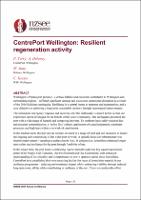CentrePort Wellington: Resilient regeneration activity

Download
Date
2021-04-14Authors
Juno, Wayne
Delaney, Anthony
Terry, Paul
Keepa, Campbell
Metadata
Show full item recordAbstract
Wellington’s Pipitea port precinct - a critical lifeline and economic contributor to Wellington and surrounding regions – suffered significant damage and associated operational disruption as a result of the 2016 Kaikoura earthquake. Resilience is a central theme to regeneration, and a core objective to achieving a long term sustainable business through incremental improvements.
The immediate emergency response / recovery after the earthquake presented the port with a wide range of hazards and competing interests. To confront these safely required fast and accurate communication of current state and hazards, a ‘safety first’ culture, application of sound engineering judgement, consistent processes and high trust within a network of contributors.
In the medium term, the port and its partners invested in a range of hard and soft measures to ensure the ongoing safe connectivity of the wider port network. A specific focus for infrastructure was interim improvement / securing to address latent risks. In conjunction, demolition enhanced longer term safety, and resilience for the port through flexibility of use.
In the longer term, the port team is embracing regeneration with enhanced understanding of its critical risks and how it operates. CentrePort have established their own recycling facility for reuse of demolition material in our resilience programme – reducing environmental impact whilst enhancing viability through reduced long term costs, all the while contributing to resilience of the port. There is considerable effort being put into ground resilience and an increased sense of community with all port staff sharing a common workspace in Shed 39.
